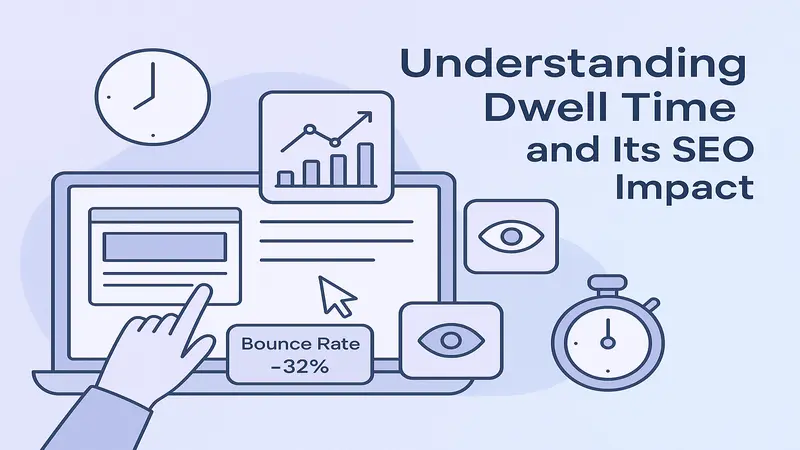
Have you ever clicked on a Google result, skimmed the page, and immediately hit the back button? That exact moment—between your click and return—is what we call dwell time. Dwell time might seem like a small detail, but it carries big weight when it comes to user experience and search engine performance. Let’s break it down in the simplest terms and explore how it affects SEO.
What Is Dwell Time?
Dwell time is the time a user spends on your webpage after clicking it from the search engine results page (SERP) but before returning to the SERP.
Imagine a person looking for “best travel backpacks.” They click your blog, read your content for three minutes, and then return to Google. That’s a 3-minute dwell time.
It reflects how engaging or useful your content is to the visitor who landed on your page from search results.
Dwell Time vs Bounce Rate vs Session Duration
People often confuse dwell time with other metrics like:
- Bounce Rate – Percentage of visitors who land on a page and leave without taking action.
- Session Duration – Total time a user spends on your website in one visit.
- Dwell Time – Time spent on a single page after clicking from a search result.
In short, dwell time is more about search satisfaction than general user behavior.
Why Does It Matter for SEO?
Search engines want to keep users happy. If a user clicks on a result and quickly leaves, it could be a sign that:
- The content wasn’t helpful
- The page was slow or hard to read
- The site didn’t meet expectations
Now, while Google hasn’t officially confirmed dwell time as a direct ranking factor, it does look at user signals to judge page quality. If users stay longer, it usually means the content is relevant and helpful—things that Google rewards indirectly.
Is Dwell Time a Google Ranking Factor?
Not directly. Google doesn’t give your page a score based solely on dwell time.
However, low dwell time + high bounce rate can signal low content quality or poor UX. That can lead to lower rankings over time.
Google uses AI and user behavior data to assess what results satisfy people. If your page gets a lot of “quick exits,” it may eventually rank lower, even without an official “dwell time score.”
What Affects Dwell Time?
Let’s explore the top things that influence how long people stay on your page:
1. Content Relevance
If your headline promises one thing and the content delivers another, people leave. Make sure your content answers the query immediately and clearly.
2. Site Speed
Nobody waits around for a slow website to load. A delay of just 2–3 seconds can reduce dwell time drastically. Use lightweight images and fast hosting.
3. Mobile Friendliness
More than half of all users browse from their phones. If your site isn’t mobile-optimized, they’ll leave quickly.
4. User Experience (UX)
A clean layout, readable fonts, and easy navigation keep people engaged. Avoid pop-ups and clutter that frustrate readers.
5. Readability
Break up your text with subheadings, bullet points, and visuals. People scan before they read. Make that scan easy.
How to Improve Dwell Time (Easy Tips)
1. Hook Them Early
Your intro should grab attention in the first few seconds. Ask a question, make a bold claim, or address a pain point directly.
Example:
“Struggling to get people to stay on your site? You might be losing the SEO game before you even realize it.”
2. Use Internal Links
Guide visitors to related content. If someone is reading about SEO, link them to your blog on backlinks or page speed.
This keeps them on your site longer and signals search engines that your site is worth exploring.
3. Add Visuals and Videos
Images, infographics, and videos break up the text and hold attention. Pages with videos often see significantly higher dwell times.
4. Make It Easy to Scan
Use:
- Short paragraphs
- Bullet points
- Bolded key phrases
- Headings every few hundred words
A wall of text scares readers away. Simple formatting keeps them reading.
How to Measure Dwell Time
Dwell time isn’t a built-in metric in Google Analytics, but you can approximate it by looking at:
- Time on Page (for organic search traffic)
- Average Session Duration
- Bounce Rate (contextually)
Tools like Microsoft Clarity, Hotjar, and Crazy Egg also show scroll depth and heatmaps—good indicators of how engaged your audience is.
Mistakes That Kill Dwell Time
Let’s quickly highlight what to avoid:
- Clickbait Titles – If your content doesn’t deliver on the headline, users leave fast.
- Too Many Ads or Pop-ups – These annoy users and reduce reading time.
- Slow Load Times – Nothing drives people away faster than a slow-loading page.
- Unclear Navigation – If users can’t find what they’re looking for, they bounce.
Conclusion:
Dwell time may not be a direct ranking factor, but it’s a powerful signal of user satisfaction. And satisfaction is exactly what Google is chasing.
If your pages are engaging, easy to read, and genuinely helpful, users will naturally stay longer—and that’s something search engines will notice over time.